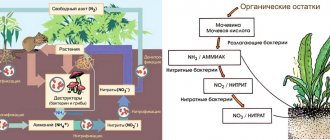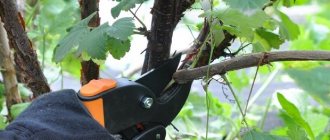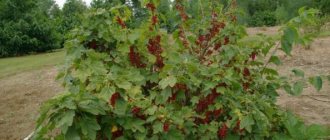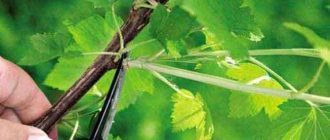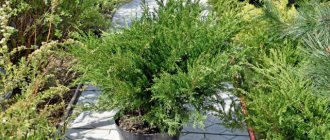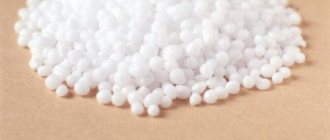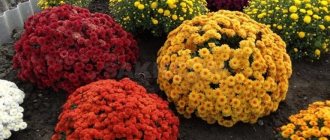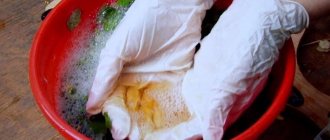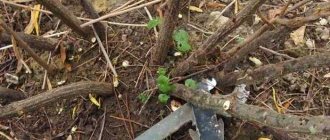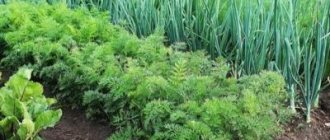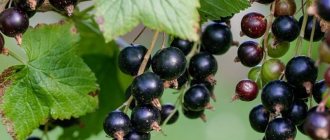Currants cannot always grow healthy and produce a full harvest without the help of the owner. This is not to say that this is too delicate and capricious a plant, but problems with its cultivation arise quite often. However, it is not at all difficult to rid currants of all diseases if they are planted correctly and subsequent treatments are carried out in a timely manner.
- 1.1 Spilling boiling water against mites and powdery mildew
1.1.1 Video: processing currant bushes with boiling water from a watering can
- 1.2.1 Photo gallery: common chemicals for processing currants
- 2 Treatments during the season
2.1 Pest control
2.1.1 Photo gallery: means for controlling currant pests
Deadlines
Carry out autumn treatment of currants against pests and diseases in late September - early October. By this time, the fruit harvest is completed, the bushes are pruned. If you are growing a red variety of berries, wait until the leaves fall off on their own before processing. You can remove the leaves from black currants manually.
Weather conditions on a sanitary day are no less important. Choose a time when it is not very cold and dry outside. If you treat currants in the rain, the preventative agents will be washed off with water, the procedure will be absolutely useless.
Safety precautions
Ferrous sulfate is considered a chemical compound with low toxicity, but if it comes into contact with mucous membranes and skin, it can cause burns or irritation. Therefore, plant processing is carried out in full gardener equipment:
- respirator,
- protective glasses,
- latex gloves,
- cap,
- closed shoes,
- tightly buttoned overalls.
After gardening work, you need to wash your face. If the solution gets on the skin, rinse with plenty of water and baking soda. If the burning sensation does not disappear, you should visit a doctor.
Keep the drug out of reach of children and animals, separately from food. It is prohibited to dispose of remaining product with household waste.
Autumn processing
Step-by-step treatment of currants in the fall from pests and diseases involves several agricultural procedures. This is the prevention of crop infection by diseases and the treatment of already infected units. If care is timely, regular and correct, then bushes of fragrant berries are easily protected from such troubles as:
- Powdery mildew;
- Septoria (white spot);
- Rust;
- Striped mosaic;
- Gray rot;
- Sawfly;
- Aphid;
- Spider mite;
- Whitefly;
- Leaf roller;
- Fire butterfly;
- Glassware.
For each type of parasites, infectious, fungal diseases, specific agents and chemicals are selected.
Insecticides for pests
They affect larvae and adults by contact (by contact) and aerial methods (through inhalation of toxic vapors of a chemical agent).
For autumn treatment of currants, use the following insecticides:
- Karbofos. Removes aphids, bud moths, scale insects, and ticks from the ground. Available in tablets, powder, emulsion, granules. For spraying, prepare the following solution: mix 75 g of the product with a bucket of water. For 1 bush you will need at least 1.5 liters of the prepared mixture.
- Commander. A systemic insecticide used against a wide range of insects and pests.
- Confidor. Effective against beetles and aphids. Does not accumulate in the root system or soil. The mixture for spraying is prepared in the following proportions: 5 ml of product per 6-7 liters of water.
- Actellik. Developed on the basis of pirimiphos-methyl. It enters the body of pests and disrupts the functionality of all their life systems. It works very quickly. To spray currants you need the following solution: 2 ml of product per 1.5 liters of water.
- Urea (urea). Effectively fights copperhead and aphids. Increases the yield of berry crops if used as a fertilizer. To spray bushes, 50-70 g of urea are diluted in 1 liter of water.
Insecticides for currant treatment
On a note! To avoid pest resistance (addiction), periodically change the chemicals used to treat all types of plants in the garden.
Fungicides for fungal diseases
Fungicides are special chemicals used to control fungi. Among the effective preparations for treating currants in the fall against pests and diseases are the following:
- Copper sulfate. The active metal actively affects pathogenic microorganisms immediately after entering the soil. Most effective during the active infection phase. Considered universal. Used for spraying shrubs, less often for watering. To irrigate the crop, you need to take 100 g of vitriol and dilute it in 10 liters of water.
- Burgundy liquid. Multifunctional tool. Suitable for the treatment and prevention of fungal diseases, at the same time fertilizes currant bushes with calcium. For autumn processing, you will need to dilute 40 g of dry matter in 10 liters of water. Actively spray the bushes with the resulting liquid.
- Bordeaux liquid. It is a mixture of copper sulfate and slaked lime. A 1% solution is suitable for caring for currants. The drug is effective in combating mold, gray mold, powdery mildew, rust, and spotting. The protective effect of Bordeaux mixture lasts 2 weeks, so shrubs infected with an unpleasant disease are treated twice: in autumn and spring. The dry substance for spraying is diluted in proportions of 40 g per 10 liters of water.
- Topaz. An economical and effective drug against powdery mildew. To prepare a bucket of solution you need 2 ml of product. It is important to treat all bushes, even if only one is sick. It is better to use at temperatures not lower than +4°C. Be sure to irrigate the bushes, the ground underneath them, and the fence if the bed is located directly next to the fence.
- Inkstone. It is actively used for caring for currants in the fall, if there is a risk of aphids, spider mites, sawflies, and moths settling in the garden bed with bushes. To prevent diseases, use a 1% solution, for treatment - 2.5%.
Fungicides for currant treatment
Watch a video about autumn treatment of currants from diseases and pests:
On a note! Copper sulfate should not be overused. It is poisonous to animals, plants and insects. If the concentration of the drug is exceeded, it leads to burns of the trunks and leaves of the berry crop.
Biological drugs
Proper treatment of currant bushes in the fall from pests and diseases using chemicals does not harm the berries and the garden as a whole. But many gardeners prefer to use biological agents as protection against harm. They contain living microorganisms.
All environmental products are divided into two types:
- To combat fungi - biofungicides.
- For poisoning insects - biosencticides, biocaricides, bioinsectoacaricides.
According to the advice of experienced gardeners, processing currants in the fall for winter will be more effective using the following environmental products:
- Actofit: used for the prevention of aphids and mites.
- Phytofer: fights aphids, leaf rollers, mites.
- Fitoverm: effective against felt mites, spider mites, and sawflies.
- Bitoxibacillin: kills adult insects and larvae by disrupting their intestinal functions.
- Fitosporin: helps in the treatment and prevention of rust and powdery mildew.
The effect of using biological products for berry crops occurs quickly, after 5-7 hours. The total duration of the beneficial effect is about 20 days. At the same time, the bushes, soil and environment do not suffer from harmful chemicals.
How to treat a greenhouse with copper sulfate in the fall
The substance is an excellent means for treating a greenhouse in the fall. Work begins in the off-season, when the growing season of greenhouse crops is over.
Copper sulfate in a greenhouse in the fall will ensure complete disinfection of not only the soil, but also the frame of the greenhouse where pests can overwinter. To use the dissolved drug sparingly, use a sprayer. After the harvest is complete, all nooks and crannies in the greenhouse are thoroughly sprayed with a chemical.
When the solution is absorbed, you need to dig up the soil. This treatment of the greenhouse with copper sulfate in the fall is carried out at the stage of preparation for the next season. Nutrients accumulate in the soil. At the same time, fungal spores that hide in the cracks to overwinter die.
Folk remedies
Currant processing in the fall can also be done using the same means that our grandmothers used. They were prepared without the use of harmful chemicals, which is important for the safety of the person who will later eat the fruits from the sprayed bushes.
Among the numerous folk recipes for treating currants against parasites and diseases, the following are considered the most effective:
- Garlic tincture An unpleasant, pungent odor repels insects, preventing them from reproducing and growing colonies. To prepare the solution, you need to crush 2 heads of garlic, add 1 liter of water at room temperature and leave in a jar with a lid for 7 days. Before use, dissolve 0.5 liters of the product in a bucket of water and spray the bushes.
- A decoction of wood ash will help with signs of powdery mildew. Take 400 g of ash, pour it into a bucket of water and boil it. Let it brew for a day and use it to spray currants.
- Celandine Kills aphids and moths. Place dry celandine grass (3 kg) in a bucket and fill with water. Leave for 2 days. Strain the mixture and use to irrigate the bushes from roots to tops.
- Laundry or tar soap The advantage of this product is its unpleasant odor. Insects avoid inhaling it, get scared and leave the inhabited area. Soap medicine is absolutely safe for plants. Prepare the solution as follows: grate a tar block on a fine grater and pour boiling water over it. Dissolve thoroughly and you can use. To enhance the effect, add mustard to the water (2-3 tablespoons per 10 liters).
- Onion A fragrant vegetable that rids currants of butterflies, aphids and mites. You need to prepare medicine only from the husk. Take 200 g of dry onion peel and pour boiling water (10 l). Leave for several hours or overnight. Treat the root part of the crop and shoots with the product. Pour the remaining solution into the soil, under the roots.
- Tobacco dust A foul-smelling product repels all pests. Buy tobacco dust at the store or prepare it from shag leaves: dry and grind. Then pour 400 g of the product into a bucket of warm water and leave for a day. Use the prepared infusion for a short time, otherwise the medicine will lose its beneficial properties. Tobacco dust can be used twice: in early spring and before winter.
Folk remedies act on insects and plants slowly, so you should not expect instant results. But after using ash, soap, onions, and garlic, your garden will definitely be safe.
Pest Control
Gardeners use iron sulfate as an insecticide to destroy harmful insects, their larvae and eggs. Surface treatment kills up to 30% of pests, but spraying must be done before the beginning of the growing season so as not to damage young foliage and inflorescences. The procedure is carried out in the spring with a 1% solution, and in the fall the composition is made more concentrated - 3%.
Whitewashing the root part of the branches will protect the bush from the appearance of ants. Small ants are not terrible for currants, but they protect aphids, which suck nutritious juices from the branches. The leaves of the affected plant curl, young shoots wither, and fruits do not set well. In addition, aphids transmit viral diseases.
Unfortunately, treating currants with iron sulfate in the spring will not help in the fight against bacterial infections. We'll have to look for other means.
Prevention
Currants are a vulnerable crop, often affected by fungal diseases, infections, and destroyed by insects. Preventive measures help keep the berry crop healthy and strong, and this guarantees a rich harvest. The list of necessary procedures looks like this:
- Pruning bushes in autumn;
- Renewal of seedlings every 4-6 years;
- Plant staking;
- Mulching the soil, loosening;
- Fertilization with fertilizers;
- Treating bushes against parasites and diseases at least 2 times a year: in spring and autumn;
- Periodic inspection of bushes for timely detection of possible diseases;
- Thorough cleaning of the area, burning of fallen leaves.
On a note! You should also be careful about the garden tools used for pruning shrubs. Before use, wipe scissors and pruning shears with alcohol.
Benefits for currants
In its pure form, copper sulfate is not required for comfortable growth and fruiting of currants. In high concentrations, it leads to damage to roots, leaves and shoots. However, in the form of an aqueous solution, the drug is useful as a highly specialized fertilizer, a powerful remedy against infection by diseases and pests.
When currants need to be treated with copper sulfate
In plant cells, copper is involved in all redox processes. The trace element improves the formation of chlorophyll, stimulates the absorption of carbohydrate and nitrogen molecules. The need for this substance acutely appears in the early stages of the growing season in spring, as well as in autumn, when the metabolic rate decreases. The second important role of copper for shrubs is strengthening immunity to infection by infections, fungi and bacteria. Find out about the best varieties of currants in this article.
It is especially important to use copper-containing fertilizers when growing currants on substrates with a large amount of organic matter. They demonstrate effectiveness in peat and reclaimed areas.
Is it possible to treat the plant to prevent diseases?
Watering or spraying garden crop bushes with copper sulfate is an important part of disease prevention. The product affects all pathogens of fungal infections. Helps protect plantings from powdery mildew, anthracnose, rust, spotting and other dangerous diseases. Planned treatment is carried out twice per season - in spring and autumn, and also optionally when signs of infection are detected. Copper-containing fungicides directly affect the mycelium and destroy spores. With regular use, they increase the resistance of the plant.
Feeding and fertilizing
Thanks to fertilizing the soil under currant bushes and fertilizing, the berry crop becomes more resistant to infections and parasites. In autumn, saturate the soil with the following mineral and organic elements:
- Phosphorus and potassium. Place 1 tbsp under the bushes. chlorine-free potassium and superphosphate. Then water the bed with warm water. It is correct to carry out such agricultural procedures once every 2 years.
- Saltpeter. You can feed currants with saltpeter in the fall only in late August - early September. Apply 15 g per 1 m², without exceeding the dose, so as not to burn the root system of the shrubs.
- Manure. It needs to be added to the soil once every 3-5 years. Mullein retains moisture in the soil and activates photosynthesis. For 1 bush you will need 10 liters of rotted manure diluted with 10 liters of water.
- Compost. Prepare in advance by throwing leaves and grass into the hole. Mulch the soil under the bushes no earlier than November, since this fertilizer will take 2-4 months to decompose.
Gardeners usually get organic matter for free, so in the fall you can spend a little on complex store-bought fertilizers. The preparation “Autumn” is well suited for currants. It is diluted with water according to the instructions and watered the bed with seedlings.
Preparation of the solution: general rules
The compositions are mixed in glass or plastic containers. Iron utensils are not suitable for these purposes, because when the crystals come into contact with the metal walls, a chemical reaction occurs that weakens the effectiveness of the treatment.
A tablespoon will help determine the required amount of the drug. For example, to prepare a 1% solution you will need 2 liters of clean water and ½ tbsp. spoons of powder.
It is strictly forbidden to dilute iron sulfate in combination:
- with preparations based on phosphorus,
- with alkalis,
with lime.
Autumn whitewashing of trunks is carried out with iron sulfate and whitewashing compounds without lime. The mixture does not penetrate deep tissues, so the effect is limited to two weeks.
The bushes are processed on a windless day. You should first monitor the weather forecast for the coming days to avoid any precipitation. The iron sulfate solution is easily washed off from the surface of the plants, so spraying will have no effect in the rain.
Iron sulfate has a powerful effect and threatens to burn young leaves. It is best to use it in autumn and early spring, when the branches are free of foliage.
Trimming
When pruning currant bushes in autumn, be sure to get rid of:
- Young shoots that greatly thicken the bed.
- Barren branches.
- Sick and withered branches. Remove them at the root and burn the cuttings.
- Thin, weakened shoots.
You need to cut the branches with perfectly even scissors, starting from the center of the bush. You cannot remove too many shoots at one time, as this will greatly weaken the culture. Make the cuts above the outer bud (1 cm). Prescribe the sanitary procedure for October-November, before the first frost.
You need to take care of the berry crop regularly; it does not tolerate neglect. Knowing how to process currants in the fall, and applying the information received in practice, you can provide yourself and your family with a rich harvest of berries in the summer, and make a variety of desserts for the winter.
